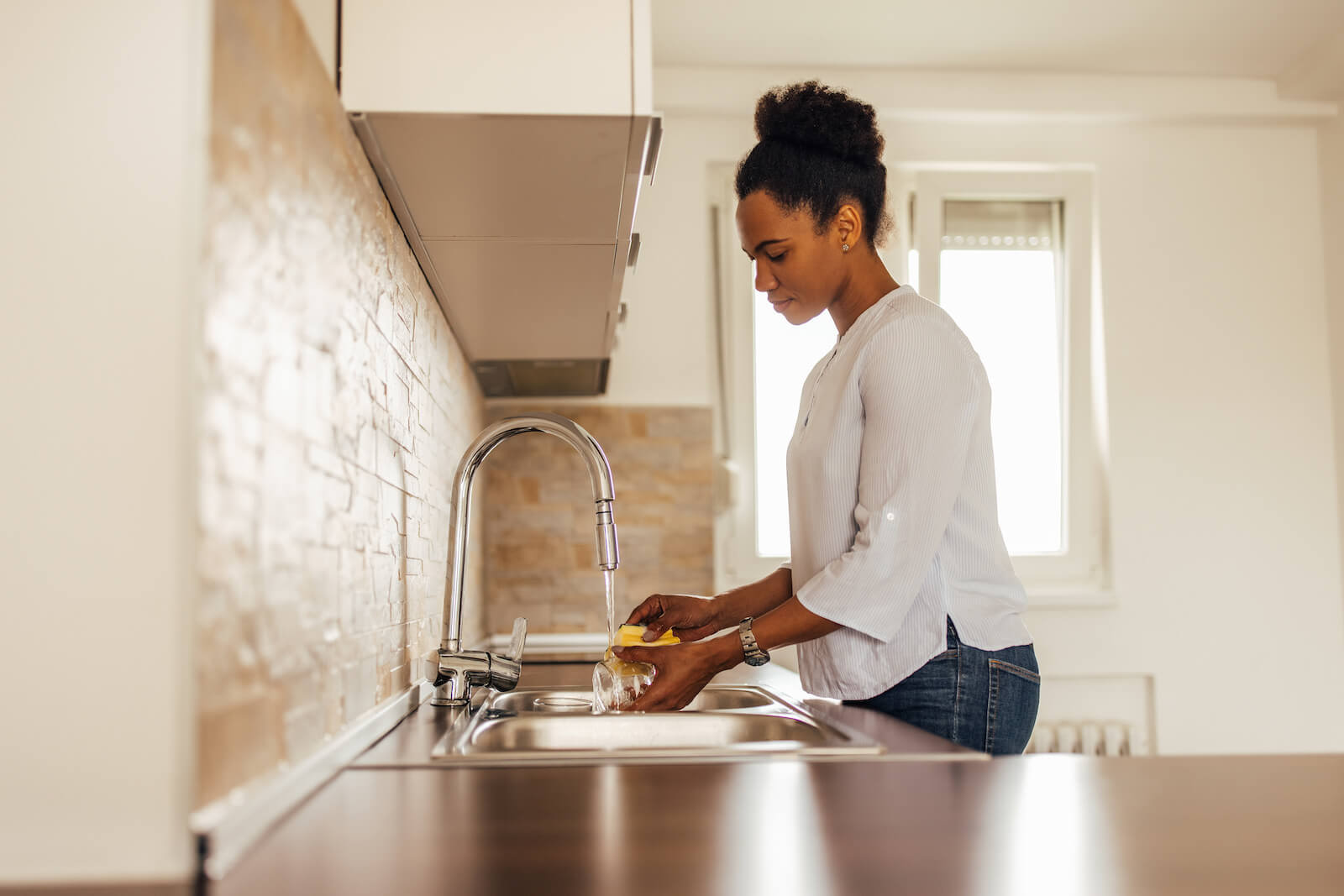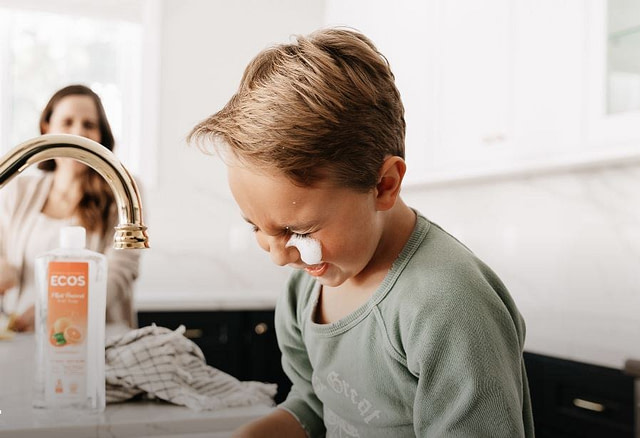How to Clean a Sink: 7 Eco-Conscious Tips
6 minute read

Studies show that keeping your home clean can make you feel better in just about every way—you sleep more soundly, you’re more likely to stay physically well, and you reduce your cortisol (AKA liquid anxiety).
If you’re anything like us, your kitchen and bathroom are probably at the top of your deep-cleaning checklist. After all, you need a semi-organized space and clean dishes to prepare meals, and most people want to clean their bodies in a space that—well—isn’t dirty.
But, you might be glossing over a critical piece of the cleanliness puzzle—making sure your sink is germ-free, sparkling clean, and draining effectively. In this article, we’re going to break down everything you need to know about how to clean a sink. Whether you have a stainless steel sink, ceramic sink, or porcelain sink, we’ll cover cleaning frequency, why to choose eco-conscious cleaners with our formula is 100% vegan formulas, the chemicals to avoid, and so much more.
#1 Clean Your Sink Often
First, let’s talk about frequency.
You might spot-clean your bathroom sink before hosting a dinner party or rinse out your kitchen basin after doing the dishes, but how often do you use cleaning products on your sinks to eliminate germs and odors?
We recommend keeping your current habits—regular rinse-outs are perfectly healthy—but throwing in a sink deep-clean about once a week.
While your kitchen sink is important too, cleaning your bathroom sink (especially hardware like the handles and drain plug) is crucial to eliminating germs that can aerosolize and settle throughout your bathroom when you flush the toilet. Studies show that flushing your toilet can effectively spray germs that can spread diseases—like E. coli—into the air, so cleaning your sink is a surefire way to reduce your interaction with particles that can make you sick.
Learning this might make you want to deep clean your bathroom sink—and the kitchen sink, for good measure—every day. If you have the time, go for it, but even a weekly sink rehab can reduce germ transmission.
#2 Use the Right Tools the First Time
Instead of trying out a million different tools to find out what works best, we’re going to give you the skinny on the best sink-cleaning equipment. Pick up the following the next time you head to the local hardware store or add them to the grocery list:
- A plumbing snake narrow enough for your drain opening
- A toothbrush specifically for cleaning (so, it doesn’t have to be fancy)
- Small, reusable sandwich bags
- Rubber bands
- Eco-conscious cleaner
- A high-quality, natural soft sponge or washable microfiber cloth
In addition, save and up-cycle an old toothbrush to help out with those hard-to-reach spots.
When your drain is clogged, having a cleaner snake on hand makes it so much easier and quicker to unclog. Plus, snaking your drain every time you clean your entire sink and garbage disposal—whether or not you have a clog—can help you prevent clogs in the first place.
Toothbrushes are a life-saver for hard-to-reach areas, like the tiny gaps between the bathroom sink hardware and the backsplash (where hard water stains and gunk love to stake their claim).
But, one of the best sink-cleaning hacks of all is the sandwich bag trick. It goes a little something like this:
- Fill a reusable sandwich bag with a small amount (less than a quarter cup) of a U.S. EPA Safer Choice certified limescale remover.
- Wrap the reusable sandwich bag around your faucet head, dunking it into the cleaning solution.
- Use a rubber band—or a hair tie—to secure the bag to the faucet head.
- Set a timer for a half-hour, come back, and empty the gunky solution into the drain.

The faucet-soaking trick can help remove limescale and mineral buildup from the mesh strainer that slightly filters the water before it flows into your sink. Clearing the gunk will improve your water pressure and send mineral buildup packing.
Lastly, you’ll use the natural sponge to wipe your entire sink and other surfaces.
#3 Choose the Right Products
While a high-quality, eco-conscious all-purpose cleaner is an excellent choice for just about any cleaning circumstance, you might want to consider stepping it up a notch in the bathroom.
You’ll feel much better about the general cleanliness of your bathroom—and get better results—with our ECOS Bathroom Cleaner. Luckily, you don’t have to resort to harsh, chemicals. Instead, our bathroom cleaner uses plant-derived ingredients to remove smudges, soap scum and stains with the scent of tea tree oil.
And, for tough hard-water stains and water spots, where using an all-purpose cleaner might require a bit more elbow grease, consider a product with a little more stain-fighting power, like ECOS’s lemon-scented cream cleanser. Safe to use on both porcelain and stainless steel sinks, this cream cleanser tackles germs, tough stains, and water spots while scrubbing and polishing your surfaces like a dream.

#4 Steer Clear of Nasties—Harsh Substances that Could Cause Harm
Why should you opt for environmentally friendly, not-harsh cleaning solutions? Because many common household products contain potentially toxic chemicals that can injure your skin, harm your health, and assault your senses.
You might be thinking, “Okay, if most household cleaners are bad for me, my family, and the environment, I can just make my own.” But, there are three reasons why you should skip the DIY route and opt for a commercially produced, safer cleaning product:
- DIY solutions simply don’t work as well – For greasy messes (like you’ll often find in your kitchen sink, especially after fried chicken night), vinegar just won’t cut it—literally. Vinegar isn’t a surfactant, and it just can’t cut through grease, plain and simple.
- You could harm yourself – Imagine that you’ve got household chlorine bleach laying around, and you decide to use it on your porcelain sink. Then, you fill a spray bottle with vinegar to wipe down your countertops or your sink hardware with a paper towel. It seems harmless, but vinegar and bleach fumes combine to create lethal chlorine gas. DO NOT do this.
- Who has the time? – Why spend time researching and creating your own blends—when effective, safer cleaners already exist? Simply put, it’s time better spent on other chores, reading a good book, or hanging out with your family.
At ECOS, our products are made without the nasties—toxic chemicals that could damage your sink and your physical health.
#5 Take Preventative Measures
While we recommend doing a sink deep clean once per week, you can take preventative measures all week long to reduce your efforts. Try the following to keep your sink cleaner, maintain its functions, and lighten your load on deep cleaning day:
- Spray and wipe your sinks with all-purpose cleaner after you do the dishes or before hopping into the shower.
- Avoid rinsing food particles or grease down the drain. Try to clear as much food debris into the trash can as possible before rinsing off your plate to avoid drain clogs, and pour hot grease into an empty aluminum can to prevent drain damage.
- Avoid rinsing hair down the bathroom sink drain. After doing your hair, do your best to gather any fallen strands and throw them in the trash to prevent clogging.
- Never rinse harsh chemicals—like hairsprays, nail polish, and hair dyes—down the sink to prevent a rust stain on the drain or other staining. These chemicals can also harm the environment once they escape your drain. Instead, use warm water and a soft cloth that you can toss into the washing machine.
#6 Don’t Skip Other Surfaces
While you’re deep cleaning your sink, why not wipe down the surrounding countertops? You already have the cleaning materials out, and you can improve the appearance of both your sink and the rest of your bathroom or kitchen with just a few extra seconds of effort.
Plus, if you clear your countertops of food particles, hair, and liquid spills from the surrounding area, they won’t make their way into the sink to begin with. If prevention is the best medicine, you can treat your sink by staying equally vigilant with your countertops.
#7 Clear Clogs ASAP
While snaking your drain during your weekly deep clean and avoiding rinsing solids and grease down the drain will certainly help prevent clogs, sometimes they’re unavoidable.
Perhaps you hosted a family dinner, and your mother-in-law kindly offered to do the dishes, rinsing every leftover morsel and an entire pan of bacon grease down the drain. Maybe your daughter cut her own hair and swept every strand down the bathroom sink before you got home from work. No matter how vigilant you are, clogs happen sometimes.
But, clearing them as soon as possible is crucial, even if it’s not sink cleaning day. By tackling clogs sooner rather than later, you’ll prevent bacteria buildup, avoid nasty odors, and simply keep your sink working as intended.
As always, steer clear of harsh chemicals like lye for clog-clearing—instead, stick with the snake.

Clean Your Sink Without Harmful Chemicals
While your parents may not have taught you how to maintain a clean kitchen sink, imagine how proud they’d be if they saw you diligently wiping away tough stains, dissolving minerals stuck in your faucet filter, and taking preventative measures to protect your sinks and drains.
But, they’d be even more proud of you for using safer, plant-powered cleaning products that protect your family from harsh, potentially harmful chemicals. At ECOS, we don’t just make products that keep your family protected from nasty substances—we also make products effective enough to brag about to even the nitpickiest sink-cleaners. To expand your efficient cleaning habits, see our other tips to learn how to clean a shower and how to clean a dishwasher.
Simply put, we care about the health of families and our environment, and our products embody those values. If you’re ready to ditch the nasties, look no further than our line of best-selling, plant-powered cleaning products. Plus, they’re made in Climate Positive factories!
